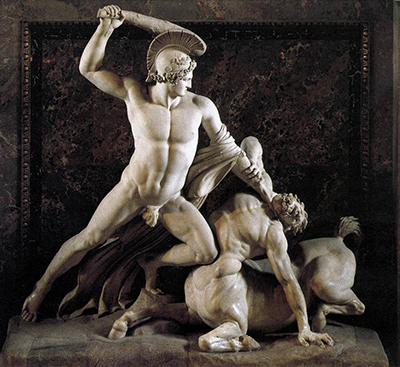Theseus and the Centaur is a marble sculpture by the Italian Neoclassical Sculptor Antonio Canova. The sculpture features Theseus just about to defeat the Centaur, by kneeling on his chest and holding a club to strike him with.
The shape of the sculpture resembles a triangle, with Theseus's foot, his helmet, and the Centaur's hand as the triangle's points. Napoleon commissioned the sculpture for the Corso Como in Milan. After this, Austria's Emperor Franz I acquired the piece for the Volksgarten Temple of Theseus. It can currently be seen in the Kunsthistorisches Museum in Vienna, and has been there since 1891.
A similar sculpture, called Theseus and the Minotaur, was commissioned by the Venetian Ambassador in Rome, Girolamo Zulian. It depicts Theseus sitting on the body of the Minotaur, after killing it. It was so well crafted, that people at the time believed it to be copied from an original Greek statue, and were shocked, and impressed, when they found out how modern it actually was. It can now be viewed at London's Victoria & Albert Museum, and is considered to be one of Canova's greatest works. Canova's love of sculpture was passed on from his grandfather. When his father died, and his mother remarried, he was sent to live with Pasino Canova, his paternal grandfather. He owned a quarry and earned a living as a stonemason. He also sculpted, mainly altars and statues. His father also worked as a stonecutter, but as Canova was only four when he died, this wouldn't have influenced him in any way.
Canova started to make models as early as nine years old, preferring to work with clay and marble. His grandfather employed him, until he became the apprentice of Giuseppe Bernardi, sometimes known as Torretto, in 1770. After two years, he went on to be taught by Giovanni Ferrari, and eventually attended the Accademia di Belle Arti di Venezia. He was very successful at the Academy, and earned multiple awards for his work. Canova was generous with his fortune, and helped students and sculptors that were struggling to get by. John Gibson and Sir Richard Westmacott were amongst the people that benefitted from his assistance. This just added to his legacy as one of the greatest Neoclassical artists of his time.




